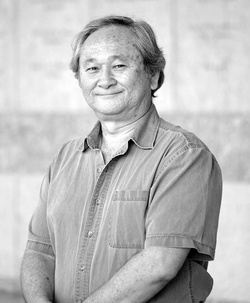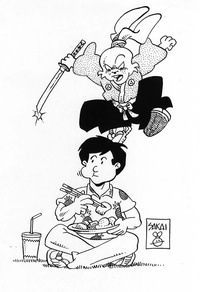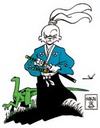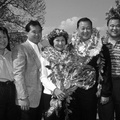When Stan Sakai’s father Akio heard that his son wanted to work as an illustrator of comic books, he was, not surprisingly, skeptical. “You can’t make a living as a cartoonist,” his father told him. “Why don’t you go into accounting or computers?” In some form, this parent-child conversation has been repeated for generations. But, even Stan himself wondered, “Should I go into business?”
Fortunately, for comic book lovers and fans of feudal Japan, Sakai utilized his skills as a commercial artist and illustrator to turn into the cartoonist he dreamed of becoming. His greatest contribution to his profession is his creation of the iconic Usagi Yojimbo in 1984, which has turned into the epic saga of Miyamoto Usagi and his adventures in the late 16th and early 17th Century Japan. From a minor character in a comic book, Sakai’s samurai rabbit has become internationally famous, with his comic books translated into a dozen languages. When Empire magazine listed the greatest comic book characters of all time, Usagi Yojimbo placed 31st, ahead of Green Lantern, Daredevil, and Hellboy and on an elite list with Superman, Batman, Wolverine, and Spider Man.
Born in Kyoto, Japan, in 1953, to a Nisei father and a Japanese mother (Teruko), Sakai explained that his mother’s family was against his parents marrying “because my dad is from peasant stock and she is from samurai.” But, his parents were determined and so Stan and his older brother Edward were born in Japan. When he was two, his family moved to Hawai`i, where his father was raised and where Japanese influences were everywhere. Sakai’s foundations of his career would come together here. A local movie theater screened Japanese films and “I’d go down every weekend and see the samurai films and the old serials.” The films of Akira Kurosawa and Hiroshi Inagaki would have a lasting impact. He also was an avid comic book reader, “even when my parents threw out my collection” and enjoyed both DC and Marvel comics. The third key factor for Sakai was taking his first art class at Kaimuki High School under an influential teacher, Lorraine Kawahara. He also had several friends who loved to draw and they spent their free time sketching anything and everything.
After graduating from the University of Hawaii with a Bachelor of Fine Arts, Sakai began working as a commercial artist, doing book illustrations, record album covers and advertisements. He moved to Los Angeles to work for a garment printing company, but spent his free time submitting ideas for stories to the comic book industry. In 1984, he gave a story idea to a cartoonist, who used it, and Stan’s has worked continuously since. While employed as a letterer for Sergio Aragones’ “Groo the Wanderer,” Sakai began writing and illustrating his own stories, including “The Adventures of Nilson Groundthumper and Hermy”.
After absorbing much from the Japanese samurai films and read about the legendary Miyamoto Musashi, Sakai was tinkering with doing a historic series set in feudal Japan. “Basically, one day I just drew a rabbit, tied up his ears to make a samurai top-knot, and fell in love with the design,” he recalled. “Instead of Miyamoto Musashi, he became Miyamoto Usagi.” Usagi debuted in 1984 with Sakai as sole author and illustrator. The books have gained a worldwide audience while changing publishers twice. Sakai diligently researches for authenticity and he revealed, “I don’t write down to kids.” He also employs a cinematic style to tell his stories. “I’m more inspired by the movies than I am by the comic books—the method of storytelling,” Sakai explained.
Perhaps, this is the secret to Usagi’s longevity. According to Empire magazine, “The noble leporid’s longevity can be put down to an intriguing mix of historical and cinematic influence, cute fluffy bunniness and an ability to slice and dice with stunning efficiency.” For his work, Sakai has received three Eisner Awards, American comic books’ industry highest honors, along with the American Library Association Award, a National Cartoonists’ Society Comic Book Division Award and a Parents’ Choice Award for “Skillful weaving of facts and legends into his work.”
Beyond his Usagi books, Sakai has written and illustrated a story for Bart Simpson’s Treehouse of Horror #7, blended Usagi into Teenage Mutant Ninja Turtles stories and developed a futuristic spin off series, Space Usagi. Working out of his home in Pasadena, Sakai enjoys the ability to spend time with his wife Sharon and their two children, Hannah and Matthew.
In trying to put his work in context, Sakai recalled, “In the scheme of things, what I do isn’t that important but I enjoy it and so do many others. Once, a mother asked me, ‘What is Usagi Yojimbo about?’ and before I could answer, her son said, ‘It’s about honor’. ” As for Stan’s father, once he attended a book signing in Hawai`i and saw how many people loved his son’s work, he had to admit, “I guess you can earn a living.”
For his work in sharing Japanese culture and history, Stan Sakai was presented the Japanese American National Museum’s Cultural Ambassador Award at its 2011 Gala Dinner.
* * *
Year of the Rabbit: Stan Sakai’s Usagi Yojimbo
July 9 through October 30, 2011
The Japanese American National Museum will present a retrospective exhibition celebrating the work of Stan Sakai, including original drawings and paintings that bring to life the adventures of his samurai rabbit.
Learn more about this exhibition >>
* * *
*This article was originally published in the 2011 Gala Dinner journal “Continuing Family Stories: The Expanding Nikkei Community” by the Japanese American National Museum.
© 2011 Japanese American National Museum










